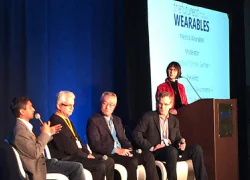
Harbinger exhibited at the Wearable Tech Show in Bay Area this December. We had a booth on software services for wearable and participated in a panel discussion on Medical Wearables.
The conference started with a great product presentation of a brain sensing headband for meditation activity. The debate on wearables future indicated that there is more innovation to come for wide-scale adoption by the market. The highlight of the conference theme was smart clothing and there were many product innovations at the display for this innovation in the textile industry.
Harbinger booth received an overwhelming response, with a wide range of enquiries alongside the execution of an IoT-based idea. Harbinger participated in a panel discussion on Medical Wearables. I was accompanied on the panel by industry experts from a design service firm, a health data product firm and a product company in wearable for pain relief. Gartner Research Director, moderating this panel, brought some very good topics for discussion. Here is an excerpt from the panel session, covering some of the areas we talked at length and some of my responses during the discussion.
Q: What are the sweet spots of opportunities for medical wearables?
A: I think the physician and patient communication is key in the healing process. It’s the trust that is built which helps patients to adhere to what doctor is saying, prescribing and even be ready to be treated/operated. The sweet spot is in the communication between physician and patient. It’s no longer an appointment based 20 min visit to the doctor, but continuous monitoring and measuring. This real-time feedback will be changing the way healthcare has been provided.
Q: What are the considerations for designing medical wearables versus consumer wearables?
A: Panel responded with factors on overall durability and ease of use versus comfort and style. They also talked about the need for designing for sick people and more targeted solutions – one wearable does not suit all patients.As a response, I mentioned about the multifold importance of medical devices and their design considerations like the accuracy of measurement, reliability of monitoring, robustness of hardware and scalability of software and security of data. For consumer wearables, the key aspect for adaptability is user experience.
As a response, I mentioned about the multifold importance of medical devices and their design considerations like the accuracy of measurement, reliability of monitoring, robustness of hardware and scalability of software and security of data. For consumer wearables, the key aspect for adaptability is user experience.
Thus, the difference is that for a medical wearable, institutes or physician are the first consumers to recommend it to a patient. Many of the consumer-focused companies have sensors that are easy to wear, they’re slick, they’re light and they look cool as well as they have a long battery life. Some of these need consideration of FDA approvals, exemptions, so all need right classification for compliances.
Q: How to drive real value propositions for hospitals and doctors?
A: Based on some of the recent work done by Harbinger for a wearable product company, I tried to comment on this. The value proposition for individual professionals and for institutes are at different levels. Doctors want to know how patient are taking the prescriptions, right dosage, on schedule and are there any side effects, how can they quickly reach to them for reactions. For hospitals, the key challenges are how efficiently they can address the service calls by the patient, productivity of staff, tracking of quality. The nursing station on each floor has a system to address call bell next to bed but they don’t know if its life threatening emergency or the patient just needs water.
So, I described how wearables can help to categorize service calls. Can it help to detect situations like falls? Is patient having the comfort or there are any issues with sleep like noise or cleanliness? Is patient getting medicine/injection on schedule? The hospitals get really benefited by tracking quality of such services and improve their scores in surveys for providers on quality of service such as HCAHPS. All these areas have great potential for both doctors and providers to use tech innovations in wearables.
The discussion went over time with all exciting comments and we wrapped up with touching some of the areas related to the hurdles in wearable adaption by medical community. There are multiple open discussion points that can be debated at length such as compliance hurdles, privacy of wearable data going into cloud and commercial viability of products etc.
Overall we see great potential with wearables in healthcare. Recent report by McKinsey indicated the IoT innovation will be revolving around Human and primarily Healthcare. The developed economies will strive for improved healthcare at optimal costs.






